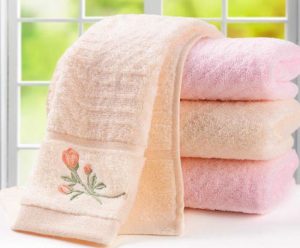- Jacquard
Jacquard is the embossed pattern of textiles interlaced by warp and weft. There are many types of textiles, and jacquard fabrics are one of the major categories. Jacquard fabrics can be divided into home textile materials and fashion fabrics. As early as the ancient Silk Road, Chinese silk is famous for its jacquard weaving. Embroidery is just a kind of decoration. Generally, the embroidered fabrics are plain-encrypted fabrics, and the jacquard is relatively high-grade. The requirements for cotton yarn can be raised, and the quality of the cotton yarn cannot be formed. Jacquard is also It is divided into plain jacquard and twill jacquard.
Fabric features:
Jacquard fabrics are very versatile, not only for making casual trousers, sportswear, suits but also for bed materials. Fabrics are comfortable to wear and are popular. “Stretch Satin” fabric is made of polyester FDY Daguang 50D*DTY75D+Spandex 40D. It is made of satin weave in the weaving machine. Because the warp is made of the large filament, the fabric is attractive and light. The advantages of suppleness, flexibility, comfort, and luster occupy a place in the fabric market.
The polyester low-elastic yarn is used as raw material. The fabric structure is made of satin and plain weave. It is interwoven on the air jet loom. The fabric is then desiccated, pre-shrunk, softened, etc., and the fabric is particularly breathable and soft to the touch. Smooth, the fabric has a width of 150cm.
Jacquard satin is a new fabric that combines comfort, modernity, and artistic sense. It attracts merchants with its attractive charm and its sales are quite good.
Jacquard machine:
Usually, a rafter (foot pedal) is used to control a heddle (the device that lifts the warp) to weave the pattern. In order to weave the pattern, the number of heald frames is increased. The two heald frames can only weave the plain weave. – 4 heald frames can weave twill weave, and more than 5 heald frames can weave satin weave. Therefore, in order to weave a complex flower with a large flower-shaped cycle, it is necessary to divide the warp yarn into more groups, and more and more flower machines are gradually formed. According to the “Xijing Miscellaneous Notes”: There is a giant deer Chen Baoguang’s wife woven flowers and flowers, “machinery with 120”, so many kinds of comprehensive weaving is very cumbersome, when the Three Kingdoms Ma Jun “old opportunity to lose money The change of the sun is the change of the 60th. The sixty-sixth comprehensive model is a twelve-in-one comprehensive method, which adopts the method of bundled jacquard, which facilitates the operation and improves efficiency.
The flower-style jacquard machine appeared in the Eastern Han Dynasty, also known as the Flower House. It is the representative of the highest achievements of ancient Chinese weaving technology. It uses a thread made a flower to store the jacquard program and then pulls the warp opening with a twisted line. The flower is a set of procedures for storing the pattern information on the jacquard machine, which is woven by the foot line representing the warp and the ear line representing the weft according to the pattern requirements. When the machine is on the machine, the foot line is connected with the fiber line that lifts the warp. At this time, pulling the foot line on the side of the ear line can enhance the related warp. When weaving, the upper and lower two people cooperate, one person is a flower-operating worker, sitting on the three-foot-high flower building and pulling the flowers to carry out the heads. In the Eastern Han Dynasty Wang Yi “Machine Fu”, the use of “smart and quiet women, through the network, shake the multi-volume, pitching posture” to describe the weaver and jacquard cooperation in the operation of the jacquard scene.
- Jacquard towel
Yarns of various patterns, different colors or raw materials are woven into various patterns on the jacquard. The structure of the towel is complex, the pattern is delicate and delicate, and the color is colorful and changeable. The fiber raw materials, yarn fineness, fabric structure, and warp and weft density are widely varied, and the design and weaving techniques are also complicated.


Hi there! Such a great short article, thanks!